How do Social Media Apps make money? It’s something we’ve all wondered while scrolling through reels, liking posts, or watching stories, especially since we’re not paying to use them.
The truth is, there’s a smart social media app monetization strategy working behind the scenes. Whether it’s through ads, premium features, influencer tools, or data insights, these apps are built to turn your time and engagement into serious profits.
It’s all carefully designed and every move is backed by a clever social media app business strategy. In this blog, we’re diving into how it all works and it’s going to be more interesting than you think.
Let’s break it down.
What is Social Media App Monetization?
Social media app monetization is all about turning user engagement into income. In simple terms, it's the process of how social media apps make money without charging users upfront. Think of all the time people spend scrolling, liking, sharing, and posting. That attention is valuable, and smart platforms have found ways to cash in on it.
Whether it’s showing targeted ads, offering in-app purchases, or launching exclusive paid content, these strategies are designed to generate steady revenue. A strong social media app monetization strategy isn’t just about adding ads here and there.
It’s about understanding your users, offering value, and choosing the right mix of revenue streams that align with your app’s purpose.
Market Statistics of Social Media Apps
With billions of users and huge income from ads, social media platforms have become a big part of today’s digital world. Before we understand how social media apps make money, let’s look at some overall market statistics that show how fast this industry is growing.
-
According to Smart Insights, 63.9% of the world's population uses social media apps. Also, on a daily basis the average person spends about 2 hours and 21 minutes daily on social media platforms.
-
A report by AP News shows the revenue growth at Meta Platforms, which includes Facebook and Instagram, saw a 16% increase in the first quarter of the financial year (Q1) 2025 compared to the previous year, reaching $42.31 billion. This revenue is mostly generated by advertising.
-
Social media apps now use AI to personalize feeds, suggest content, and even generate posts. It enhances user experience and increases ad targeting precision.
-
A study by Vogue Business reveles, the creator economy has evolved into a $500 billion industry, with over 50 million global influencers, highlighting the significance of social media app monetization models that support content creators.
-
With growing concerns around data privacy, some newer platforms are experimenting with decentralized models and stronger user control features. It provides extra privacy to the customers.
These statistics underscore the expansive reach and financial potential of social media platforms. Understanding these figures is crucial for developers, marketers, and anyone wondering how social media apps make money in this evolving digital world.
Top Business Models That Power Social Media Apps
This is the time to reveal the secret: “how do social media apps make money?” The secret lies in their well-planned and scalable social media app business models that revolve around turning user attention into consistent income.
While the platforms themselves may appear “free,” they’re built on strategic foundations that drive long-term profitability.
Below are the best social media apps revenue models that showcase how today's top platforms earn billions while keeping users engaged.
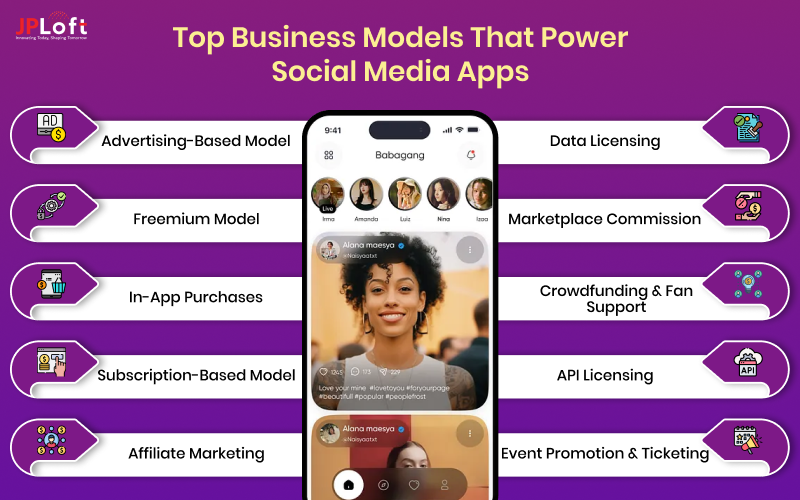
1. Advertising-Based Model
This is by far the most common monetization method. Platforms like Facebook, Instagram, and YouTube display ads in various formats like banner ads, in-feed posts, video ads, and story placements, tailored to user behavior and preferences.
These platforms offer advanced ad targeting tools, making it highly attractive for advertisers to invest. The more users engage with content, the more valuable the ad space becomes, creating a win-win cycle for both the app and marketers.
This approach forms the backbone of revenue generation in mobile social apps.
-
Why it works: It scales with user growth and offers high return on investment for advertisers while keeping the app free for users.
2. Freemium Model in Social Media Apps
With the freemium model, users get core features for free and can unlock premium features for a price. Think of LinkedIn Premium or Reddit Premium, these upgrades might include ad-free browsing, analytics tools, or boosted visibility.
This model attracts a large user base initially and then monetizes the most engaged users. It's an ideal choice when you want to maintain wide accessibility while also having a steady income stream.
It effectively answers the question how free social media apps make money without limiting user access.
-
Why it works: It builds a large audience quickly and allows for targeted upselling of premium features.
3. In-App Purchases & Virtual Goods
This model lets users buy coins, badges, gifts, or filters to enhance their app experience or support creators. TikTok, Twitch, and YouTube Live use this model to great effect.
Users spend small amounts frequently, which adds up significantly due to the platform’s large user base. This creates strong user interaction and drives more creators to stay active.
It’s one of the smartest strategies for in-app monetization for social media apps focused on entertainment and creator-driven platforms.
-
Why it works: It drives microtransactions at scale, increases engagement, and supports content creators directly.
4. Subscription-Based Model
Under this model, users pay a monthly or yearly fee for added perks like ad-free content, exclusive posts, or premium tools. Subscriptions often appeal to power users who need extra utility or convenience. This is a sustainable option in any social media app monetization strategy.
Also, keep in mind that the development cost of social media apps can vary, depending on the features and monetization methods you choose to implement.
-
Why it works: It ensures steady revenue while rewarding user loyalty with premium experiences.
5. Affiliate Marketing & Sponsored Content
Many creators and influencers promote third-party products in exchange for commissions or flat fees. This benefits both the creators and the app, which may take a share of the earnings or encourage deeper platform engagement.
Instagram, TikTok, and YouTube are hubs for influencer marketing. Platforms may also run native sponsored campaigns, generating additional revenue. It's a core component of modern social media app business strategy.
-
Why it works: It monetizes content organically without relying entirely on traditional ads.
6. Data Licensing & Analytics Services
Aggregated, anonymized data is often licensed to research agencies or advertisers for insight into user behavior and trends. Platforms like Facebook and Snapchat provide analytics tools to business users, sometimes for a fee.
While this method requires strict privacy policies, it offers significant revenue potential without impacting regular users. Ethical data use and transparency are key in this model.
While this method requires strict privacy policies, it offers significant revenue potential without impacting regular users. Ethical data use and transparency are key in this model.
It's often part of backend social media app monetization strategies, and consulting with the best mobile app development company can help you implement this feature in a secure and scalable way.
-
Why it works: It leverages existing data for passive income while maintaining user experience.
7. Marketplace Commission Model
Some apps act as platforms for buying and selling, think Facebook Marketplace or TikTok Shop. The app earns a percentage of each sale, integrating e-commerce within the social experience.
This model works especially well for lifestyle and fashion-centric content where discovery leads to purchases. It also adds another layer of utility to the platform.
It fits well with broader business models of social media app ecosystems.
-
Why it works: It creates direct revenue from transactions without relying on external platforms.
8. Crowdfunding & Fan Support
Apps like Patreon or features like YouTube's “Super Thanks” allow fans to directly support their favorite creators. This is ideal for niche communities and long-form content creators who rely on loyalty rather than viral reach.
Fans get perks like exclusive content, shoutouts, or badges in return. It supports creators and motivates consistent, quality content. For platforms centered on creators, it’s a vital piece of the monetization strategies for social media platforms.
-
Why it works: It empowers communities to support content they love while rewarding creators.
9. White-Labeling & API Licensing
Some social platforms open up their tools, APIs, or algorithms to developers or businesses. For example, social login integrations or embedded comment systems on third-party sites.
They charge for API access or white-labeled services that extend their tech capabilities to others. This model adds an additional stream of revenue beyond the core app and can also offset the overall cost to create an app by generating income from external usage.
It’s often used in more technical or B2B-focused social media app business models.
-
Why it works: It monetizes platform infrastructure and creates partnerships with developers and businesses.
10. Event Promotion & Ticketing
Some social media platforms allow users or creators to promote and sell tickets to live events, webinars, or workshops. Platforms like Facebook and LinkedIn offer event-based features, often earning through ticket fees or promotional boosts.
This model works well for business, educational, and entertainment communities. It's also an effective blend of networking and revenue generation.
You can even create a social media app centered on community events and monetization from the start.
-
Why it works: It builds real-world value while driving in-app activity and revenue.
These business models showcase the innovative ways social media apps generate revenue while maintaining user engagement. If you’re planning to create an app that blends engagement and revenue, learning from these models is the best place to start.
How Top Social Media Apps Make Money?
When considering the best social media apps, it’s important to understand how these platforms turn user engagement into profit.
The top apps have developed smart business models that leverage user data, behavior, and content to generate revenue while keeping users hooked.
Here is the short analysis on some of the top social media app monetization strategies.
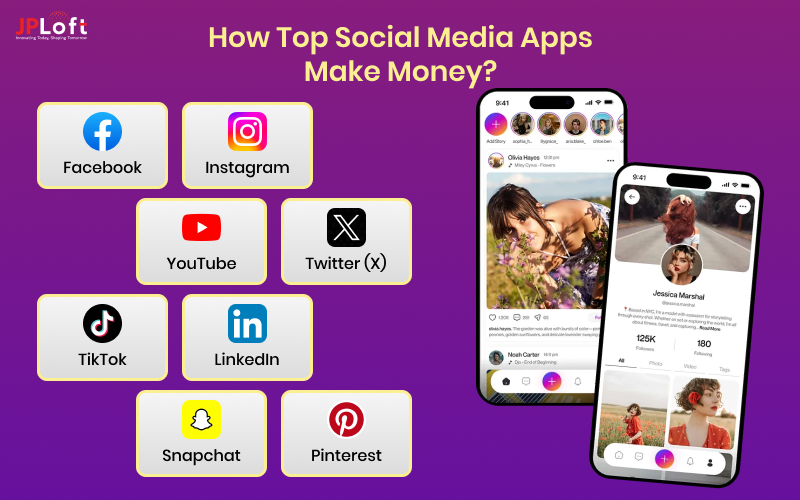
|
Name of the App |
How it Works |
Revenue Source |
|
|
Facebook relies on targeted ads using user data such as behavior, interests, and demographics. Ads appear in various formats across the platform. |
Revenue comes from businesses and advertisers who pay for ad placement, creating a consistent income stream. |
|
|
Instagram integrates sponsored posts, influencer collaborations, and shoppable posts that allow users to purchase directly within the app. |
Revenue comes from paid partnerships, sponsored content, affiliate marketing, and shoppable posts. |
|
YouTube |
YouTube earns revenue primarily from ads placed on videos. Users can also subscribe to YouTube Premium for an ad-free experience and exclusive content. |
Revenue comes from ads, subscription fees (YouTube Premium), channel memberships, and creators’ shares of ad revenue. |
|
Twitter (X) |
Twitter Blue provides users with additional features for a monthly subscription. Advertisers pay to promote tweets and engage users with ads. |
Revenue comes from Twitter Blue subscriptions, promoted tweets, and ad placements. |
|
TikTok |
TikTok generates revenue through virtual coins and gifts purchased by users to support creators. Ads are displayed between videos and as sponsored content. |
Revenue comes from in-app purchases (virtual coins), ads, and partnerships with creators for branded content. |
|
|
LinkedIn offers Premium subscriptions with additional features like job insights and networking tools. It also displays ads for businesses targeting professionals. |
Revenue comes from Premium subscriptions, job listings, and advertising targeted to businesses and professionals. |
|
Snapchat |
Snapchat features Snap Ads, sponsored lenses, and geofilters, all tailored to users' behavior and location. |
Revenue comes from advertisers who pay for ad placements and sponsored content. |
|
|
Pinterest displays sponsored pins that appear in users' feeds based on their interests and browsing behavior. The platform also offers ad services for businesses. |
Revenue comes from businesses and advertisers who pay to promote their pins, providing a consistent income stream. |
These mobile app monetization models highlight how the top social media apps have developed diversified revenue streams, balancing user engagement with profitable business models.
As the landscape evolves, these platforms will continue to adapt and innovate, maximizing their potential for growth and profitability.
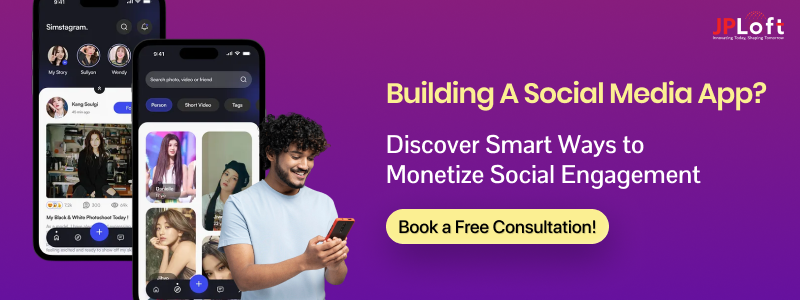
Partner with JPLoft to Launch Your Video Streaming App Successfully
Whether you're planning to create the next big social platform or a niche community app, success begins with the right development partner and that’s where JPLoft comes in.
As a leading social media app development company, we specialize in building scalable, user-friendly, and monetization-ready platforms tailored to your vision. From intuitive UI/UX design to secure backend infrastructure, we deliver end-to-end solutions that set your app up for long-term success.
Whether you're aiming to integrate features like real-time chat, content sharing, creator monetization, or smart algorithms, we’ve got the expertise to bring it to life.
Ready to launch your social media app? Let’s connect and turn your idea into a standout digital community.
Final Wrap-Up
At first, it might seem confusing how social media apps make money that are completely free. But when you look a little closer, you’ll see that these platforms have found smart ways to earn through your time and attention.
The more people use the app, the more chances they have to make money, whether it’s through ads, special features, or partnerships. And it's not just about money, it's about building value for users, creators, and advertisers alike.
Knowing the different ways you can make smarter decisions from the start. The online world has a lot of opportunities, you just need to choose the right path and take the first step.
FAQs
Social media apps generate money from various sources such as ads, in-app purchases, premium content, subscriptions, and collaborations with brands or influencers. These models enable platforms to generate money without directly charging users.
Most used monetization sources for social applications are advertising (video, display, and sponsored posts), premium memberships (subscription models), and data monetization (selling business insights).
Yes, most social media apps make money regardless of ads. They employ other tactics such as paid subscriptions, providing premium content or features, or collaborating with influencers and brands for brand campaigns.
Social networking websites gather the users' data to create in-depth profiles and use it such that they can target advertising more efficiently. This allows the sites to compensate payers for advertising campaigns that have been more accurately targeted.
Your ideal revenue model will vary based on your users and app goals. Most new platforms begin with advertising or a freemium model (providing free access with premium add-on features) and can later include paid subscriptions or partnerships to bring in extra revenue





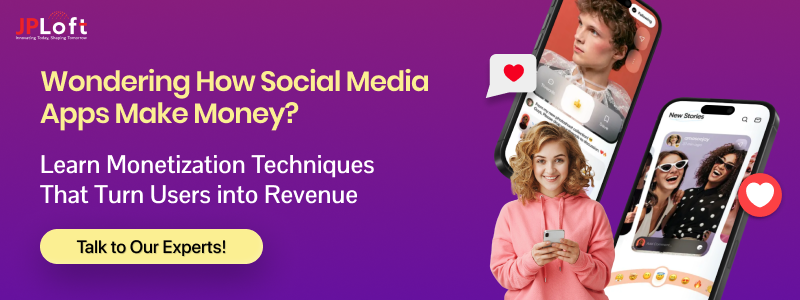

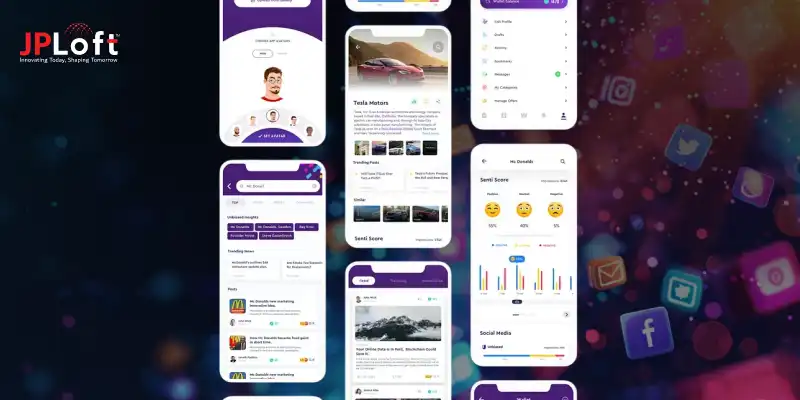




Share this blog